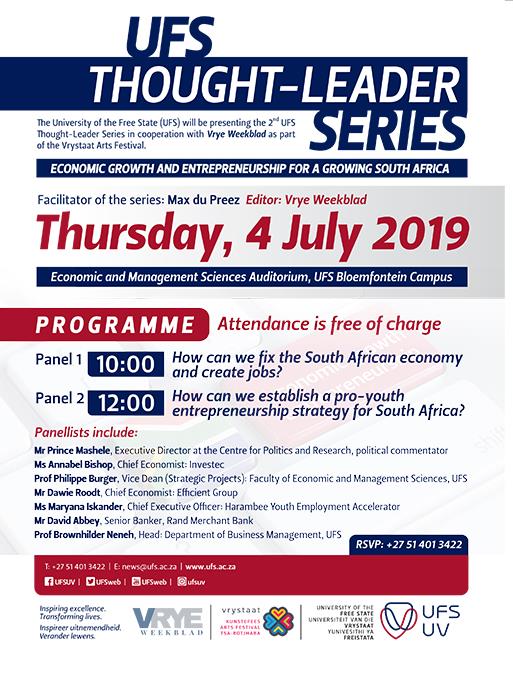The University of the Free State (UFS), in collaboration with Vrye Weekblad, presented the second consecutive Thought-Leader series on the Bloemfontein Campus on 4 July 2019, with topics focusing on economic growth and entrepreneurship for an emergent South African economy and environment. The series formed part of the literature festival of the Vrystaat Arts Festival, presented on the campus from 1 to 7 July 2019.
Rector and Vice-Chancellor of the UFS, Prof Francis Petersen, opened the discussions with the words, “We need to project ourselves as thought-leaders,” clarifying that the UFS itself is responsible for contributing to local and national public discourse by assembling industry experts to deliberate on imperative topics that affect students, the broader community, and the country in one way or another.
Editor of the Vrye Weekblad, political analyst, and master of ceremonies for the morning, Dr Max du Preez, introduced the panellists for the first discussion, themed How can we fix the South African economy and create jobs.
According to Prof Philippe Burger, Vice-Dean (Strategic Projects): UFS Faculty of Economic and Management Sciences, South Africa has the highest level of economic inequality in the world. He further explained that the long-term solution to growing the country’s economy is to improve the quality of education, which will result in a higher growth rate for the country.
Chief Economist at Investec, Ms Annabel Bishop, went on to explain that, “South Africa has a worrying de-industrialisation trend, which contributes to the decreased opportunity for decent job creation, essentially contributing to our struggling economy.” This was echoed by Executive Director: Centre for Politics and Research and political commentator, Mr Prince Mashele, who spoke on employing the unemployed. He suggested that South Africa’s youth be trained and equipped with skills so that SA gravitate more towards producing an industrial class in order to build its economy.
Director and Chief Economist of the Efficient Group, Mr Dawie Roodt, concluded the first discussion by highlighting that South Africa needs a GDP growth rate of 2,5% to at least maintain the country’s current unemployment rate and prevent it from getting worse.
The second panel discussed the establishment of a pro-youth entrepreneurship country, where the Head: Department of Business Management (UFS), Prof Brownhilder Neheh, spoke about bridging the intention-behaviour gap, and further exposing the youth to practical opportunities and teaching them the importance of group mentality as entrepreneurs. Chief Executive Officer: Harambee Youth Employment Accelerator, Ms Maryana Iskander, suggested that foreign direct investment can improve youth employment.
The final panellist to speak during the last half of the discussion, Senior Banker and Transactor: Acquisition and Leveraged Finance Division at Rand Merchant Bank – Corporate Investment Bank, Mr David Abbey, advised on tomorrow’s world of work by saying, “The focus of the workplace should always be on the people, and entrepreneurs should understand the importance of multidisciplinary skills, and emotional and social intelligence, as the future world of work requires a trusted society.”
UFS Thought-Leader Series
Programme: | | UFS Thought-Leader Series
Panel discussions: |
 | | |
| |